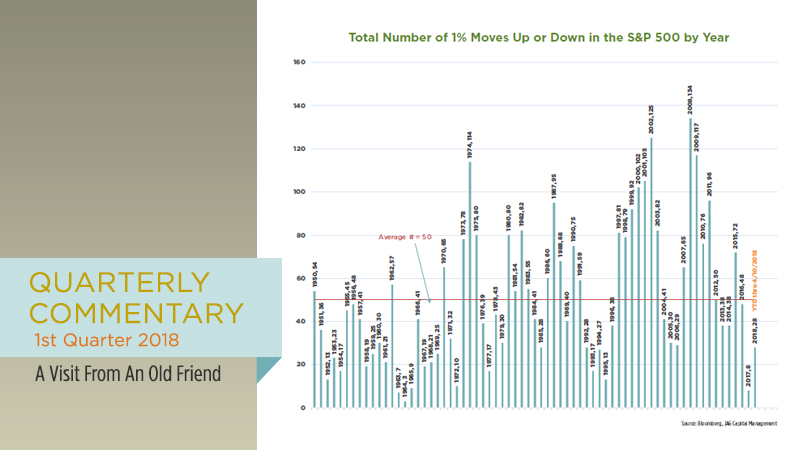Market volatility has returned from an extended vacation, resulting in a roughly 10% correction for the S&P 500 since its January high and a -.8% decline for the 1st quarter of 2018. This was the index’s first 10% correction in two years, and it broke a streak of nine consecutive quarterly gains dating back to the 3rd quarter of 2015.
For context, we should note that last year’s stock market performance was unusual for both its strength and smoothness. The S&P 500 returned 21.8% in 2017, delivering its best year since 2013 and its third-biggest yearly gain since the end of the 2008-2009 financial crisis. Meanwhile, the index experienced only eight daily price moves of at least 1% in all of 2017, the fewest since 1972. By way of comparison, in all calendar years since 1950, the index has experienced an average of 50 daily swings of at least 1% (up or down) and eleven single-day moves of at least 2%.
So far in 2018, stock investors have been subjected to a turbulent ride. Just through the first week of April, the S&P 500 has already experienced 28 daily moves of at least 1% and eight daily moves of 2% or more. While there is some truth to the old tongue-in-cheek Wall Street adage that proclaims, “Everyone can accept unlimited (upside) volatility,” we humans tend to greatly dislike downside volatility. In fact, as first described in 1979 by Nobel Prize-winning economist Daniel Kahneman and his colleague Amos Tversky, the behavioral principle of Loss Aversion compels us to abhor losses roughly twice as much as we enjoy the equivalent amount of gains. Some psychologists believe that this tendency is rooted in our evolutionary profile. Consider that our distant ancestors often found themselves on the edge of finding enough food to survive. In that kind of harsh environment, the loss of a week’s worth of food could mean death. On the other hand, gaining an extra week of food would not necessarily translate into an additional week of life (especially prior to the development of food storage and preservation techniques).


